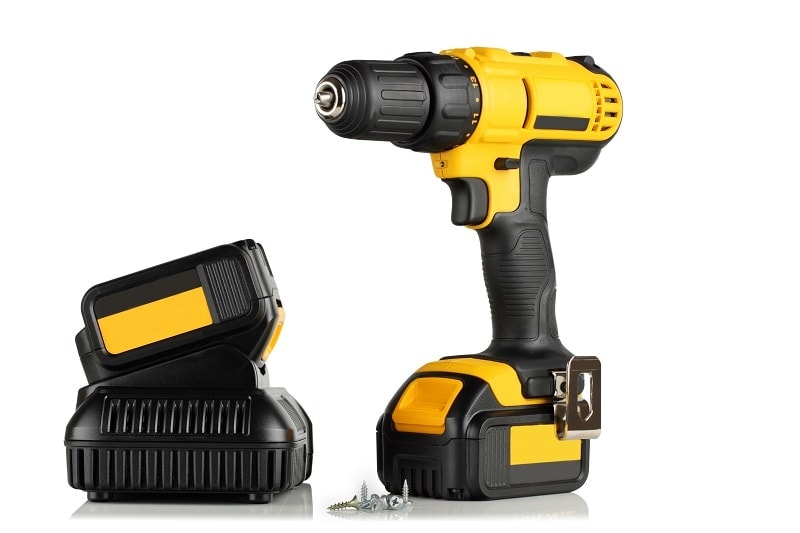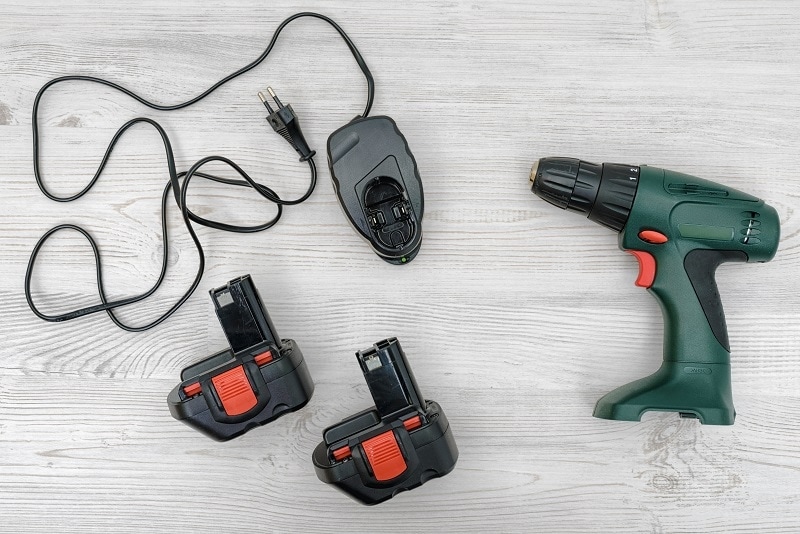How to Store & Care for Cordless Drill Batteries (Easy Guide)
-
- Last updated:


Join us while we look at how to store and care for your rechargeable batteries to get the best results from your tools and the best value for your money. Even rechargeable batteries die, but if you follow these steps, they will last a long time. Most lithium-ion rechargeable batteries will last 1000 charges or more.

Best Practices
While we are mainly concerned with lithium-ion batteries because they are in most modern drills and other power tools, there are other batteries. You might find nickel-cadmium (NiCad) batteries that manufacturers used in power tools before lithium-ion. You may also find nickel-metal hydride (NiMH) batteries that come in AA, AAA, 9-volt, etc. These best practices will work for all types unless we point out otherwise.
Keep Charged
NiCad and NiMH batteries suffer from something called a battery memory effect. What happens is that when you repeatedly charge these batteries before they fully dissipate, they will hold less charge. For instance, if you always recharge a NiCad battery when it’s down to 75%, battery memory will cause it to charge only to 75%. For this reason, you want to let your NiCad and NiMH batteries dissipate completely before you recharge them to avoid battery memory.
Lithium-ion batteries do not suffer from battery memory, so it’s best to recharge these batteries after each use, so they have a full charge when you need them.
Charge Regularly
Rechargeable batteries will lose charge if you don’t use them much faster than single-use batteries. They are not suitable emergency batteries that you can store away. If you use lithium-ion batteries, we recommend setting up a schedule to recharge them every 60 – 90 days if you don’t use them to keep them in good health and fully charged.
If you are using NiCad or NiMH batteries, you will want to find a use for them so they can dissipate enough for a recharge every 30 – 60 days.
Charge Completely
When recharging your batteries, you want to make sure they charge completely before removing them from the system. Most modern charging systems have an indicator to let you know when it’s safe to remove the battery. However, if your charger doesn’t have a meter or an LED, you’ll need to charge it for at least 8 hours.
Store in a Dry Room Temperature Environment
You want to keep your battery away from moisture to prevent the exposed metal components from corrosion. You will also want to keep it in a cool, room temperature environment, as too much heat or cold can reduce battery life or damage it. It used to be popular to store batteries in the fridge, but if you think about it, cars often have difficulty starting in cold weather because the battery dies. Never store the battery in direct sunlight.
Store Carefully
If your batteries came in a box, return them there for storage, or put them somewhere safe where they won’t get banged around. Putting several in a bag can cause the terminals to short out if they touch and colliding with one another can cause damage.
Keep a Spare
Lithium-ion batteries are expensive but having a spare will keep you covered if something should happen. Two batteries will also allow you to get more work done as they lose their charge fairly quickly when using them in power tools.
Handle with Care
While it is important to store them properly, a lot of damage happens due to improper handling when changing and using them. Never force the battery into the tool or charger. If you can’t install it correctly, stop and inspect the components to find the problem. Accidents happen but try not to drop the battery or put it on a counter where it could get knocked to the floor.
What to Avoid
Don’t Completely Discharge
It would be best to stop using your lithium-ion battery when you notice that it is losing power. Completely discharging your battery will shorten its lifespan and could damage the poles. NiCad and NiMH batteries like to lose most of their charge, but you should still stop short of draining them completely.
Don’t Overcharge

It’s a very common practice to leave your battery on the charger indefinitely, but this can dramatically reduce its lifespan. Overcharging damage will occur with all types of rechargeable batteries though lithium-ion is the most susceptible. Luckily, many modern battery chargers sold for use with power tools have a built-in automatic shutoff that allows you to keep your battery on the charger, but there are still plenty that don’t. Read your owner’s manual to see if your charger automatically shuts off or when you need to remove the battery.
Don’t Overheat
As you are using your battery in your power tools, you may notice that it can start to get warm to the touch. A little warm is ok, but if you begin to see the battery getting hot, it’s time to take a break to let it cool down. A battery that gets too hot can explode, so never attach a hot battery to a charger or store it in direct sunlight.
How to Charge Your Battery
To properly charge your battery follow these steps.
- Use your battery until you notice it’s losing power; don’t keep using it until it stops.
- Allow the battery to cool for an hour or two before connecting it to your battery charger.
- Place the battery on the charger. Allow it to charge for at least 8 hours before removing it unless it has a built-in shutoff or an indicator telling you when the battery is full.
- Store in a cool, dry place away from sunlight.
Long Term Storage
If you intend to store your lithium-ion battery for a month or more, it’s better to charge them to 80 or 90% instead of giving them a full charge to increase the battery’s life.

Summary
When you are storing rechargeable batteries, the main thing to remember is to keep them in a cool, dry place away from sunlight. Using the batteries more often will help them last longer, and you should never overcharge them or use them until they are dead. If you are storing your lithium-ion batteries long term, only charge them to 90%, and check them every 60 days to see if they need charging.
We hope you have enjoyed reading and have learned something new. If we have given you some ideas to get more life out of your batteries, please share this guide to store and care for cordless drill batteries on Facebook and Twitter.
- Related Read: How to Safely Dispose of Rechargeable Batteries
Featured Image Credit: OlegSam, Shutterstock
Contents

